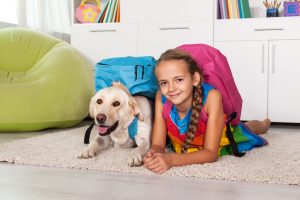Helping Your Pets Not ‘Fall’ Apart During Back-to-School Season
September 5, 2019
 Although the calendar says summer doesn’t end for a few more weeks, most people have already said good-bye to summer – especially families with children returning to school. This change in schedules can be stressful for people and pets. Being away from home during the day and after school activities, especially, can cause our fury companions to feel lonely after spending the entire summer at home with family.
Although the calendar says summer doesn’t end for a few more weeks, most people have already said good-bye to summer – especially families with children returning to school. This change in schedules can be stressful for people and pets. Being away from home during the day and after school activities, especially, can cause our fury companions to feel lonely after spending the entire summer at home with family.
Here are some tips to help your pet transition into the new school year:
1. Set a schedule and stick to it as much as possible.
Life gets busy and we can’t always stick to a schedule. It happens! However, following a general schedule of when you get up, have mealtimes, and head to bed can create some predictability and help reduce pets’ stress levels.
2. Exercise!
When the weather changes, it’s not always fun to be outside and we’re less likely to take our dogs out for as many walks. This can be hard on dogs who have no other outlet to release built-up energy. Aim to get them out at least once a day, or if you have a yard, give them time to run around and burn off energy while playing a game like fetch. While on your walks let your dog sniff around, as sniff walks are a great way for dogs to decompress.
3. Exercise… their brains!
Mental exercise is just as important as physical exercise. Mental exercise (or enrichment) can look like food puzzles, training, or fun easy activities to engage your pets. Enrichment isn’t just for dogs, though — cats can also benefit from mental stimulation. In fact, many behavioral problems can be connected to boredom and lack of stimulation. For ideas, you can search on Facebook for both canine and feline enrichment groups, do a quick internet search, or even look up ideas on Pinterest. There are ideas everywhere!
A new school year also means your children may be coming home with new friends, and while animals and children can be best of friends, not everyone gets along right away. Some children can be afraid of dogs and become overwhelmed by an enthusiastic greeter. Other children may love your fur kids but may be a little too exuberant or impolite in their interactions. Lots of yelling, chasing, or even just too much handling might scare some animals. For others, when kids get excited and start running around or playing, they might also become excited and start chasing, mouthing or nipping.
While it is recommended that you seek professional help from a positive reinforcement or science-based dog trainer for major dog-children problems, here are a few tips to help set everyone up for success:
Know your dog.
Before any clear, visible reaction, most pets communicate their feelings through subtle body language. And those signals are frequently much more subtle than most people expect. By learning to read body language, you’ll learn what makes your pet stressed, afraid, or excited. Knowing your pet also means understanding how your pet reacts to certain situations. Does your dog like to jump on people entering the home? Do loud noises startle and make your cat run for cover? Knowing how your pet will normally respond to situations (and then knowing what might happen while your child has friends visiting) can help you plan ahead. If visitors are too scary, let your cats have plenty of places to hide and escape. Or, if your dog tends to get a little overstimulated, coach visiting kids on how to properly interact with them.
Teach your dog what to do instead of the undesirable behavior.
Traditional dog training advice focuses on waiting until an animal makes a mistake and then correcting it. Instead of being reactive to a situation, we instead want to be proactive. Instead of saying “no” when they make a mistake, try to teach the dog what you want them to do in that situation before they exhibit an undesirable response. Avoid having your dog jump up on guests by practice “sit” when people enter and before getting attention. Try teaching them commands like “leave it” or cues like going to their bed during mealtime. The point is to find ways to say “yes” and teach them what we want them to do.
Manage it.
Management is a wonderful tool to be used in any good training plan. It consists of creating an environment that prevents pets from practicing undesirable behavior and thus avoids situations where they are prone to make inappropriate choices. Children aren’t always the best at reading dog body language, so if your dog has handling concerns sometimes removing the dog keeps everyone less tense. You can put your dog in another room, let the kids inside, and then bring the dog back out on a leash. That way you are decreasing the initial excitement and maintaining control while your dog interacts with guest. If you have a dog that is afraid of strangers or gets overwhelmed with a lot of handling, consider having your dog hang out in another room when guest are over.
Please note that these tips are applicable all year round! So, as a reminder, when changes happen try to maintain a consistent schedule as possible and ensure your pets are getting enough mental and physical exercise. Get to know your pet’s particular signals and read their body language in different situations so you can help set them up for success for the next season of change. Hopefully these tips can help keep everyone from “fall-ing apart” as we say “good-bye, Summer” and “hello fall!”



